Legal Rights of Gig Workers: Uber and Foodora Employee Status
VerifiedAdded on 2023/05/28
|25
|7870
|476
Essay
AI Summary
This essay examines the ongoing debate surrounding the employment status of gig economy workers, specifically focusing on Uber drivers and Foodora riders in Australia. It argues that these workers should be treated as employees, highlighting the power imbalance and lack of traditional employee benefits within the gig economy. The essay explores Australian workplace laws, including the Fair Work Act and Occupational Health and Safety Act, and discusses how these laws should apply to gig workers to ensure fair treatment and protection. By analyzing the operational models of Uber and Foodora, the essay demonstrates the dependence of workers on these platforms and the control exerted by the companies, further supporting the argument for employee status and access to associated rights and protections. The paper concludes by emphasizing the need for legislative reform to address the vulnerabilities of gig workers and ensure they receive the same rights and benefits as traditional employees.
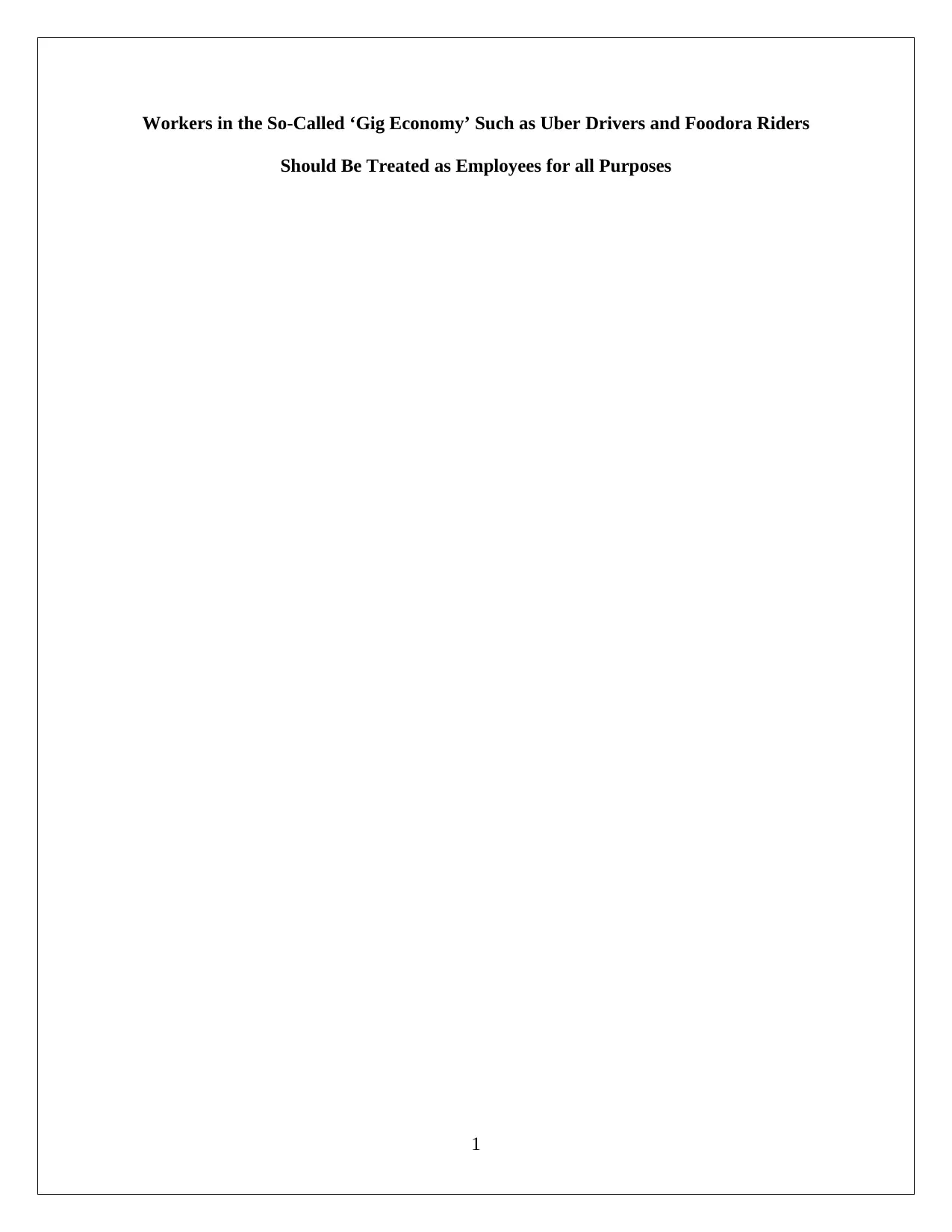
Workers in the So-Called ‘Gig Economy’ Such as Uber Drivers and Foodora Riders
Should Be Treated as Employees for all Purposes
1
Should Be Treated as Employees for all Purposes
1
Paraphrase This Document
Need a fresh take? Get an instant paraphrase of this document with our AI Paraphraser
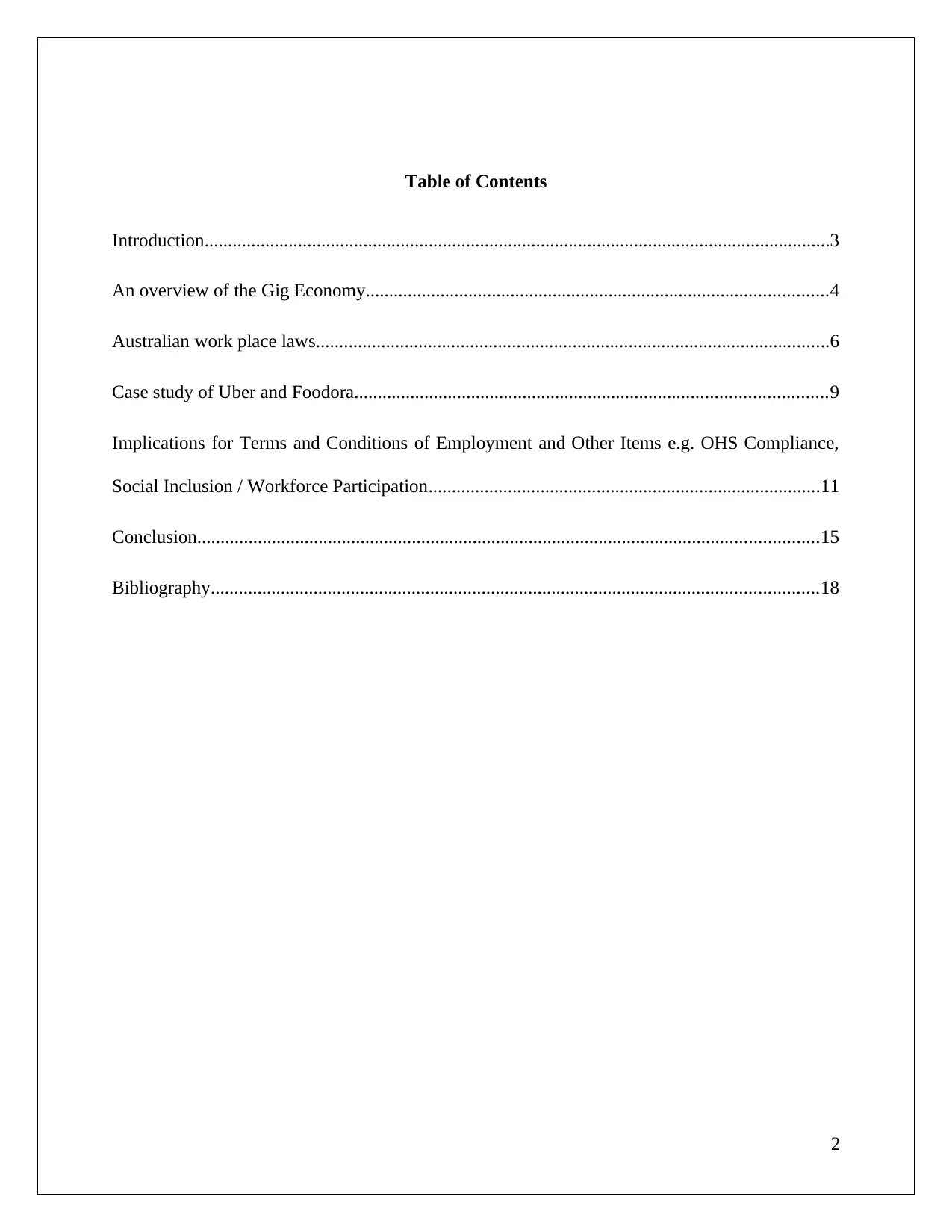
Table of Contents
Introduction......................................................................................................................................3
An overview of the Gig Economy...................................................................................................4
Australian work place laws..............................................................................................................6
Case study of Uber and Foodora.....................................................................................................9
Implications for Terms and Conditions of Employment and Other Items e.g. OHS Compliance,
Social Inclusion / Workforce Participation....................................................................................11
Conclusion.....................................................................................................................................15
Bibliography..................................................................................................................................18
2
Introduction......................................................................................................................................3
An overview of the Gig Economy...................................................................................................4
Australian work place laws..............................................................................................................6
Case study of Uber and Foodora.....................................................................................................9
Implications for Terms and Conditions of Employment and Other Items e.g. OHS Compliance,
Social Inclusion / Workforce Participation....................................................................................11
Conclusion.....................................................................................................................................15
Bibliography..................................................................................................................................18
2
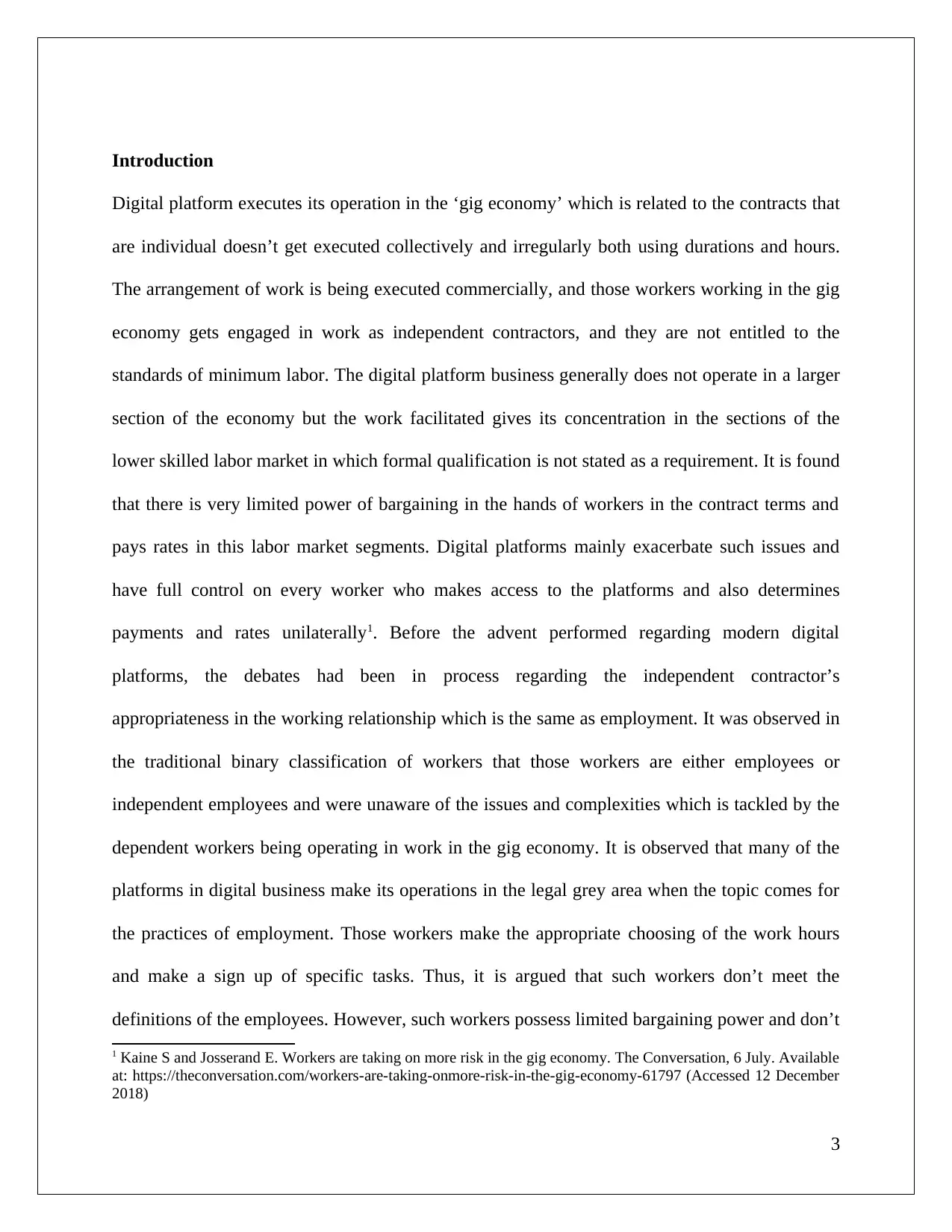
Introduction
Digital platform executes its operation in the ‘gig economy’ which is related to the contracts that
are individual doesn’t get executed collectively and irregularly both using durations and hours.
The arrangement of work is being executed commercially, and those workers working in the gig
economy gets engaged in work as independent contractors, and they are not entitled to the
standards of minimum labor. The digital platform business generally does not operate in a larger
section of the economy but the work facilitated gives its concentration in the sections of the
lower skilled labor market in which formal qualification is not stated as a requirement. It is found
that there is very limited power of bargaining in the hands of workers in the contract terms and
pays rates in this labor market segments. Digital platforms mainly exacerbate such issues and
have full control on every worker who makes access to the platforms and also determines
payments and rates unilaterally1. Before the advent performed regarding modern digital
platforms, the debates had been in process regarding the independent contractor’s
appropriateness in the working relationship which is the same as employment. It was observed in
the traditional binary classification of workers that those workers are either employees or
independent employees and were unaware of the issues and complexities which is tackled by the
dependent workers being operating in work in the gig economy. It is observed that many of the
platforms in digital business make its operations in the legal grey area when the topic comes for
the practices of employment. Those workers make the appropriate choosing of the work hours
and make a sign up of specific tasks. Thus, it is argued that such workers don’t meet the
definitions of the employees. However, such workers possess limited bargaining power and don’t
1 Kaine S and Josserand E. Workers are taking on more risk in the gig economy. The Conversation, 6 July. Available
at: https://theconversation.com/workers-are-taking-onmore-risk-in-the-gig-economy-61797 (Accessed 12 December
2018)
3
Digital platform executes its operation in the ‘gig economy’ which is related to the contracts that
are individual doesn’t get executed collectively and irregularly both using durations and hours.
The arrangement of work is being executed commercially, and those workers working in the gig
economy gets engaged in work as independent contractors, and they are not entitled to the
standards of minimum labor. The digital platform business generally does not operate in a larger
section of the economy but the work facilitated gives its concentration in the sections of the
lower skilled labor market in which formal qualification is not stated as a requirement. It is found
that there is very limited power of bargaining in the hands of workers in the contract terms and
pays rates in this labor market segments. Digital platforms mainly exacerbate such issues and
have full control on every worker who makes access to the platforms and also determines
payments and rates unilaterally1. Before the advent performed regarding modern digital
platforms, the debates had been in process regarding the independent contractor’s
appropriateness in the working relationship which is the same as employment. It was observed in
the traditional binary classification of workers that those workers are either employees or
independent employees and were unaware of the issues and complexities which is tackled by the
dependent workers being operating in work in the gig economy. It is observed that many of the
platforms in digital business make its operations in the legal grey area when the topic comes for
the practices of employment. Those workers make the appropriate choosing of the work hours
and make a sign up of specific tasks. Thus, it is argued that such workers don’t meet the
definitions of the employees. However, such workers possess limited bargaining power and don’t
1 Kaine S and Josserand E. Workers are taking on more risk in the gig economy. The Conversation, 6 July. Available
at: https://theconversation.com/workers-are-taking-onmore-risk-in-the-gig-economy-61797 (Accessed 12 December
2018)
3
⊘ This is a preview!⊘
Do you want full access?
Subscribe today to unlock all pages.

Trusted by 1+ million students worldwide
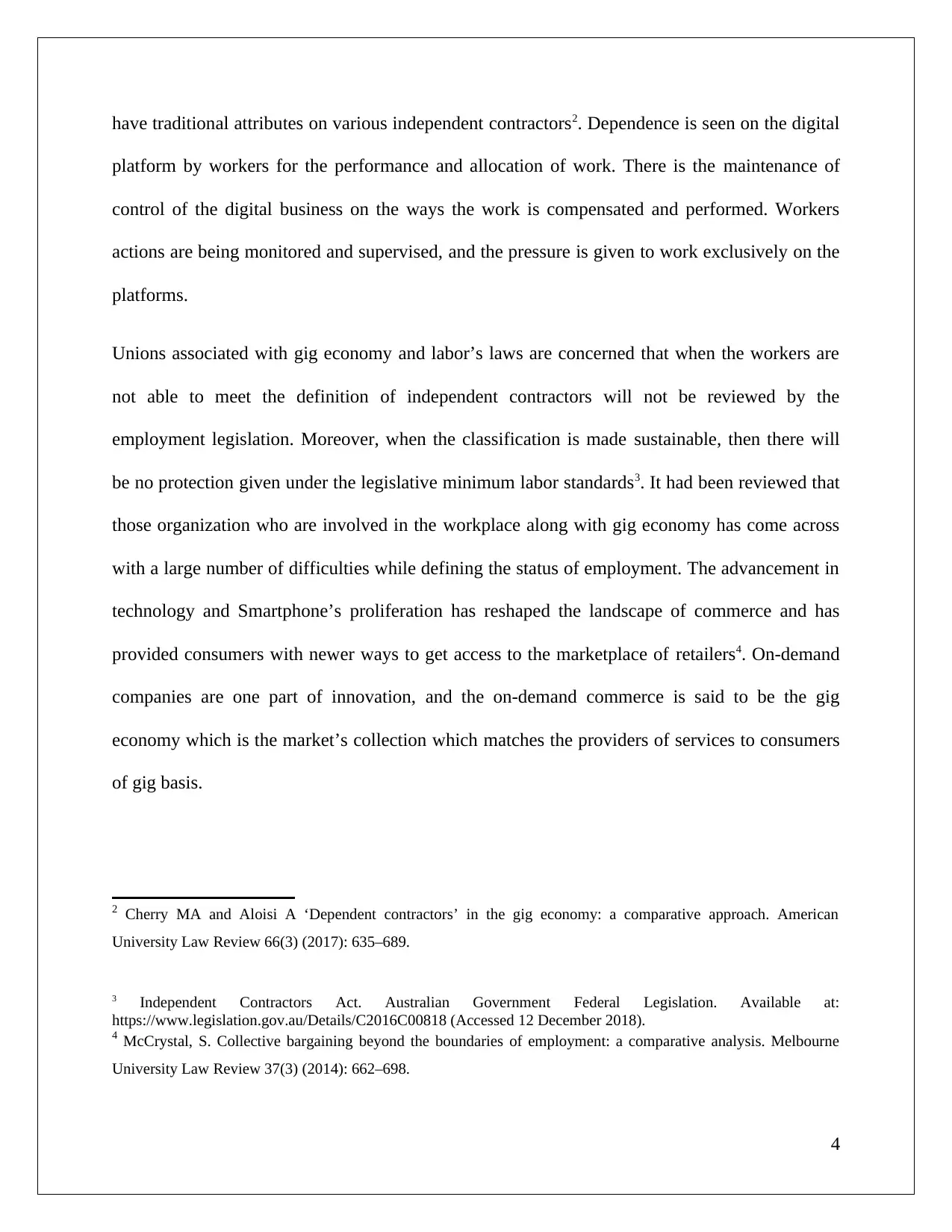
have traditional attributes on various independent contractors2. Dependence is seen on the digital
platform by workers for the performance and allocation of work. There is the maintenance of
control of the digital business on the ways the work is compensated and performed. Workers
actions are being monitored and supervised, and the pressure is given to work exclusively on the
platforms.
Unions associated with gig economy and labor’s laws are concerned that when the workers are
not able to meet the definition of independent contractors will not be reviewed by the
employment legislation. Moreover, when the classification is made sustainable, then there will
be no protection given under the legislative minimum labor standards3. It had been reviewed that
those organization who are involved in the workplace along with gig economy has come across
with a large number of difficulties while defining the status of employment. The advancement in
technology and Smartphone’s proliferation has reshaped the landscape of commerce and has
provided consumers with newer ways to get access to the marketplace of retailers4. On-demand
companies are one part of innovation, and the on-demand commerce is said to be the gig
economy which is the market’s collection which matches the providers of services to consumers
of gig basis.
2 Cherry MA and Aloisi A ‘Dependent contractors’ in the gig economy: a comparative approach. American
University Law Review 66(3) (2017): 635–689.
3 Independent Contractors Act. Australian Government Federal Legislation. Available at:
https://www.legislation.gov.au/Details/C2016C00818 (Accessed 12 December 2018).
4 McCrystal, S. Collective bargaining beyond the boundaries of employment: a comparative analysis. Melbourne
University Law Review 37(3) (2014): 662–698.
4
platform by workers for the performance and allocation of work. There is the maintenance of
control of the digital business on the ways the work is compensated and performed. Workers
actions are being monitored and supervised, and the pressure is given to work exclusively on the
platforms.
Unions associated with gig economy and labor’s laws are concerned that when the workers are
not able to meet the definition of independent contractors will not be reviewed by the
employment legislation. Moreover, when the classification is made sustainable, then there will
be no protection given under the legislative minimum labor standards3. It had been reviewed that
those organization who are involved in the workplace along with gig economy has come across
with a large number of difficulties while defining the status of employment. The advancement in
technology and Smartphone’s proliferation has reshaped the landscape of commerce and has
provided consumers with newer ways to get access to the marketplace of retailers4. On-demand
companies are one part of innovation, and the on-demand commerce is said to be the gig
economy which is the market’s collection which matches the providers of services to consumers
of gig basis.
2 Cherry MA and Aloisi A ‘Dependent contractors’ in the gig economy: a comparative approach. American
University Law Review 66(3) (2017): 635–689.
3 Independent Contractors Act. Australian Government Federal Legislation. Available at:
https://www.legislation.gov.au/Details/C2016C00818 (Accessed 12 December 2018).
4 McCrystal, S. Collective bargaining beyond the boundaries of employment: a comparative analysis. Melbourne
University Law Review 37(3) (2014): 662–698.
4
Paraphrase This Document
Need a fresh take? Get an instant paraphrase of this document with our AI Paraphraser
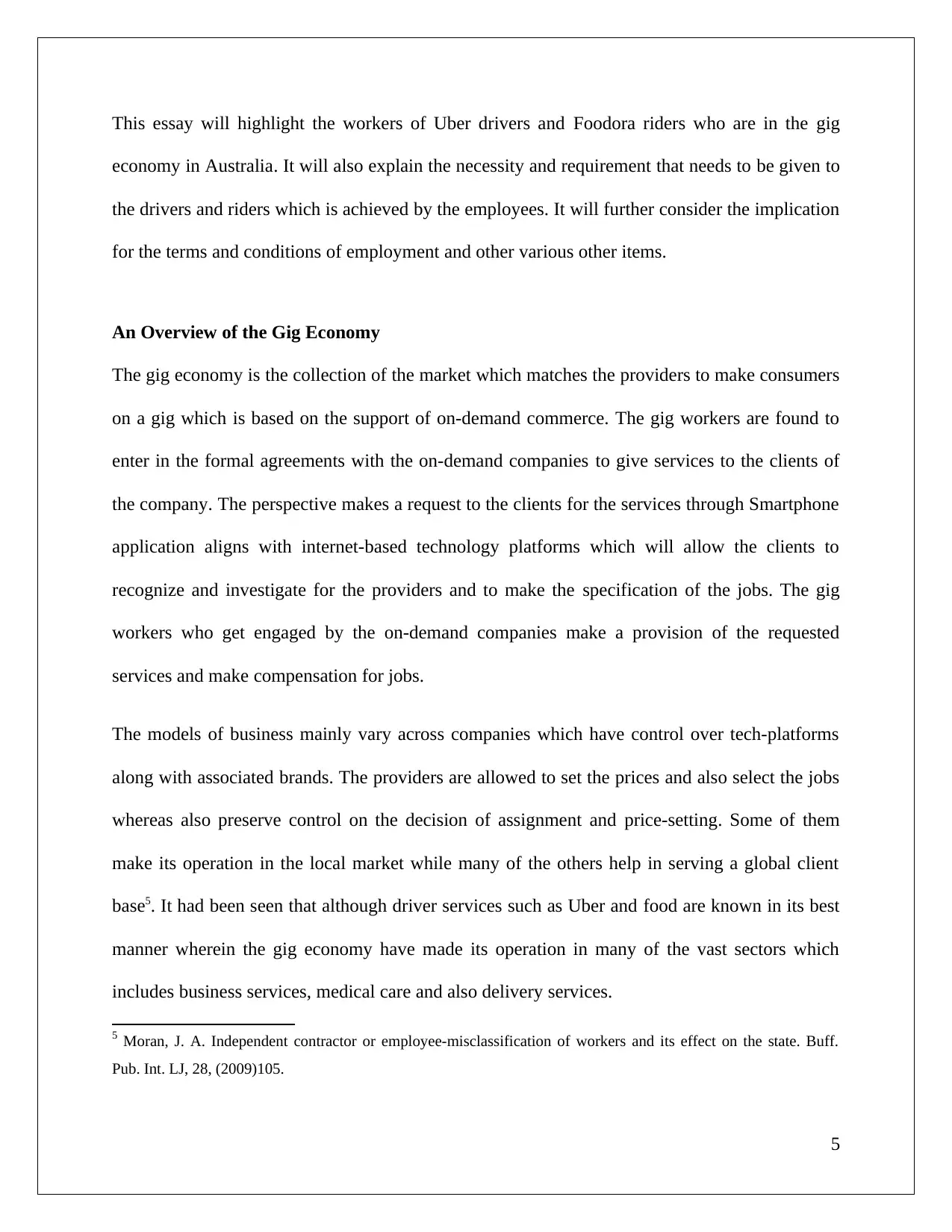
This essay will highlight the workers of Uber drivers and Foodora riders who are in the gig
economy in Australia. It will also explain the necessity and requirement that needs to be given to
the drivers and riders which is achieved by the employees. It will further consider the implication
for the terms and conditions of employment and other various other items.
An Overview of the Gig Economy
The gig economy is the collection of the market which matches the providers to make consumers
on a gig which is based on the support of on-demand commerce. The gig workers are found to
enter in the formal agreements with the on-demand companies to give services to the clients of
the company. The perspective makes a request to the clients for the services through Smartphone
application aligns with internet-based technology platforms which will allow the clients to
recognize and investigate for the providers and to make the specification of the jobs. The gig
workers who get engaged by the on-demand companies make a provision of the requested
services and make compensation for jobs.
The models of business mainly vary across companies which have control over tech-platforms
along with associated brands. The providers are allowed to set the prices and also select the jobs
whereas also preserve control on the decision of assignment and price-setting. Some of them
make its operation in the local market while many of the others help in serving a global client
base5. It had been seen that although driver services such as Uber and food are known in its best
manner wherein the gig economy have made its operation in many of the vast sectors which
includes business services, medical care and also delivery services.
5 Moran, J. A. Independent contractor or employee-misclassification of workers and its effect on the state. Buff.
Pub. Int. LJ, 28, (2009)105.
5
economy in Australia. It will also explain the necessity and requirement that needs to be given to
the drivers and riders which is achieved by the employees. It will further consider the implication
for the terms and conditions of employment and other various other items.
An Overview of the Gig Economy
The gig economy is the collection of the market which matches the providers to make consumers
on a gig which is based on the support of on-demand commerce. The gig workers are found to
enter in the formal agreements with the on-demand companies to give services to the clients of
the company. The perspective makes a request to the clients for the services through Smartphone
application aligns with internet-based technology platforms which will allow the clients to
recognize and investigate for the providers and to make the specification of the jobs. The gig
workers who get engaged by the on-demand companies make a provision of the requested
services and make compensation for jobs.
The models of business mainly vary across companies which have control over tech-platforms
along with associated brands. The providers are allowed to set the prices and also select the jobs
whereas also preserve control on the decision of assignment and price-setting. Some of them
make its operation in the local market while many of the others help in serving a global client
base5. It had been seen that although driver services such as Uber and food are known in its best
manner wherein the gig economy have made its operation in many of the vast sectors which
includes business services, medical care and also delivery services.
5 Moran, J. A. Independent contractor or employee-misclassification of workers and its effect on the state. Buff.
Pub. Int. LJ, 28, (2009)105.
5
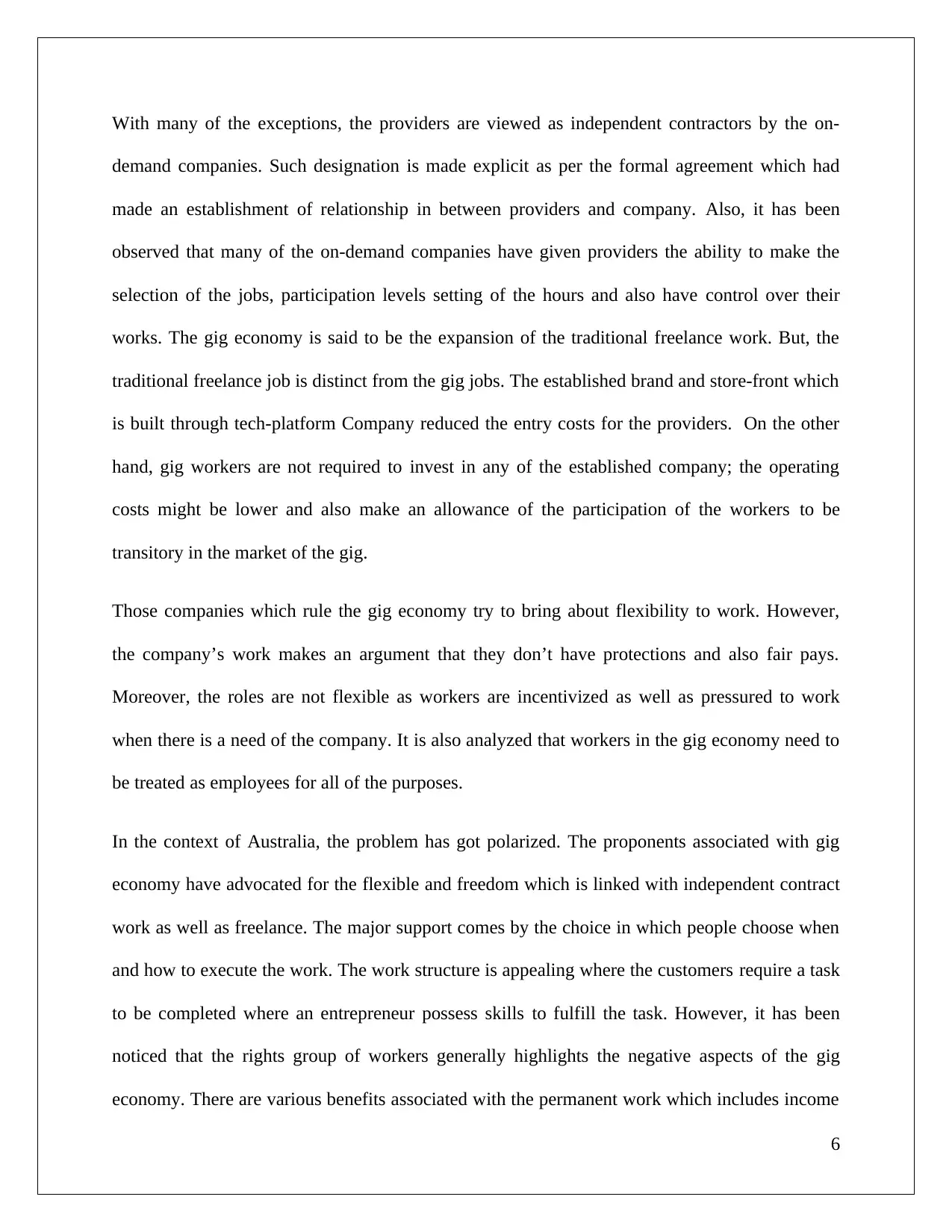
With many of the exceptions, the providers are viewed as independent contractors by the on-
demand companies. Such designation is made explicit as per the formal agreement which had
made an establishment of relationship in between providers and company. Also, it has been
observed that many of the on-demand companies have given providers the ability to make the
selection of the jobs, participation levels setting of the hours and also have control over their
works. The gig economy is said to be the expansion of the traditional freelance work. But, the
traditional freelance job is distinct from the gig jobs. The established brand and store-front which
is built through tech-platform Company reduced the entry costs for the providers. On the other
hand, gig workers are not required to invest in any of the established company; the operating
costs might be lower and also make an allowance of the participation of the workers to be
transitory in the market of the gig.
Those companies which rule the gig economy try to bring about flexibility to work. However,
the company’s work makes an argument that they don’t have protections and also fair pays.
Moreover, the roles are not flexible as workers are incentivized as well as pressured to work
when there is a need of the company. It is also analyzed that workers in the gig economy need to
be treated as employees for all of the purposes.
In the context of Australia, the problem has got polarized. The proponents associated with gig
economy have advocated for the flexible and freedom which is linked with independent contract
work as well as freelance. The major support comes by the choice in which people choose when
and how to execute the work. The work structure is appealing where the customers require a task
to be completed where an entrepreneur possess skills to fulfill the task. However, it has been
noticed that the rights group of workers generally highlights the negative aspects of the gig
economy. There are various benefits associated with the permanent work which includes income
6
demand companies. Such designation is made explicit as per the formal agreement which had
made an establishment of relationship in between providers and company. Also, it has been
observed that many of the on-demand companies have given providers the ability to make the
selection of the jobs, participation levels setting of the hours and also have control over their
works. The gig economy is said to be the expansion of the traditional freelance work. But, the
traditional freelance job is distinct from the gig jobs. The established brand and store-front which
is built through tech-platform Company reduced the entry costs for the providers. On the other
hand, gig workers are not required to invest in any of the established company; the operating
costs might be lower and also make an allowance of the participation of the workers to be
transitory in the market of the gig.
Those companies which rule the gig economy try to bring about flexibility to work. However,
the company’s work makes an argument that they don’t have protections and also fair pays.
Moreover, the roles are not flexible as workers are incentivized as well as pressured to work
when there is a need of the company. It is also analyzed that workers in the gig economy need to
be treated as employees for all of the purposes.
In the context of Australia, the problem has got polarized. The proponents associated with gig
economy have advocated for the flexible and freedom which is linked with independent contract
work as well as freelance. The major support comes by the choice in which people choose when
and how to execute the work. The work structure is appealing where the customers require a task
to be completed where an entrepreneur possess skills to fulfill the task. However, it has been
noticed that the rights group of workers generally highlights the negative aspects of the gig
economy. There are various benefits associated with the permanent work which includes income
6
⊘ This is a preview!⊘
Do you want full access?
Subscribe today to unlock all pages.

Trusted by 1+ million students worldwide
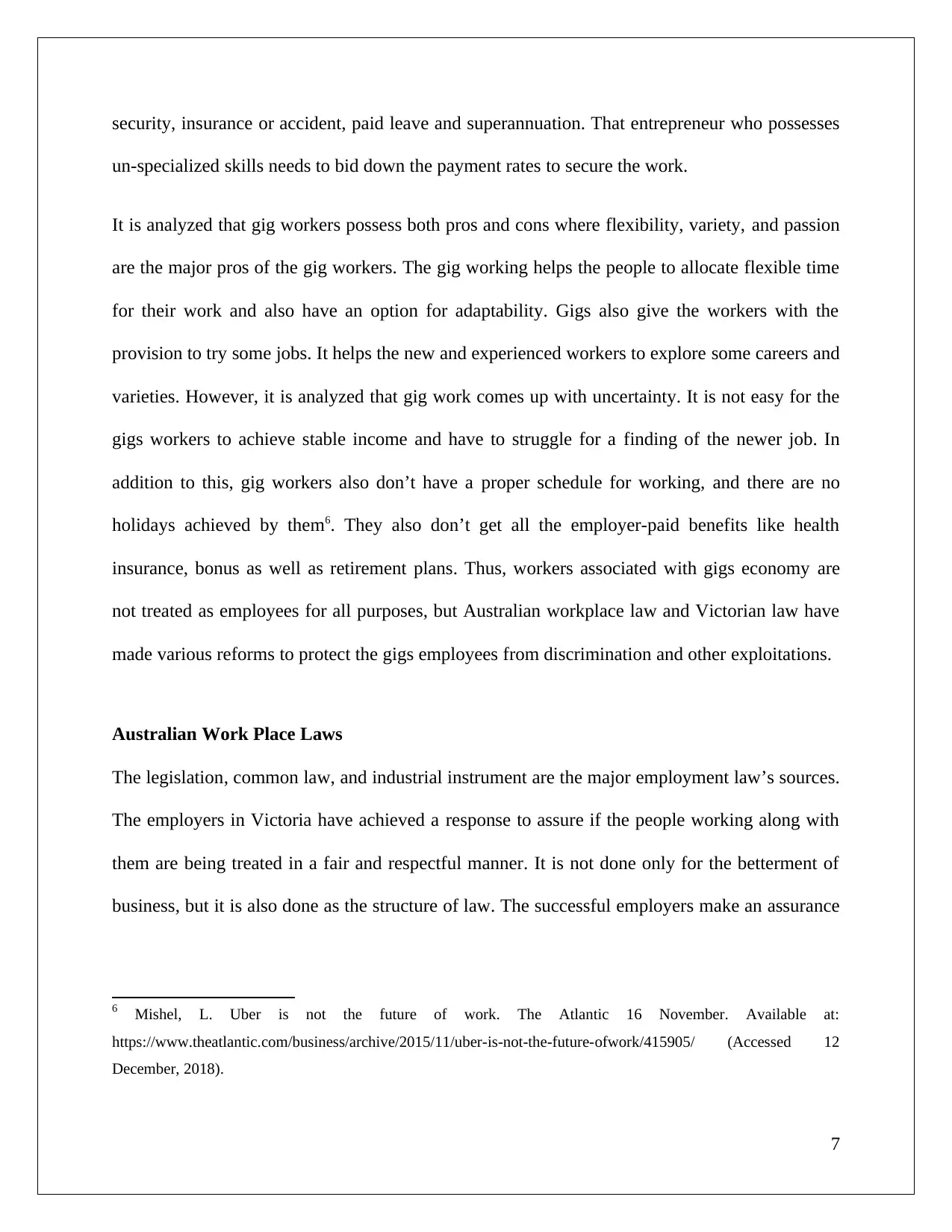
security, insurance or accident, paid leave and superannuation. That entrepreneur who possesses
un-specialized skills needs to bid down the payment rates to secure the work.
It is analyzed that gig workers possess both pros and cons where flexibility, variety, and passion
are the major pros of the gig workers. The gig working helps the people to allocate flexible time
for their work and also have an option for adaptability. Gigs also give the workers with the
provision to try some jobs. It helps the new and experienced workers to explore some careers and
varieties. However, it is analyzed that gig work comes up with uncertainty. It is not easy for the
gigs workers to achieve stable income and have to struggle for a finding of the newer job. In
addition to this, gig workers also don’t have a proper schedule for working, and there are no
holidays achieved by them6. They also don’t get all the employer-paid benefits like health
insurance, bonus as well as retirement plans. Thus, workers associated with gigs economy are
not treated as employees for all purposes, but Australian workplace law and Victorian law have
made various reforms to protect the gigs employees from discrimination and other exploitations.
Australian Work Place Laws
The legislation, common law, and industrial instrument are the major employment law’s sources.
The employers in Victoria have achieved a response to assure if the people working along with
them are being treated in a fair and respectful manner. It is not done only for the betterment of
business, but it is also done as the structure of law. The successful employers make an assurance
6 Mishel, L. Uber is not the future of work. The Atlantic 16 November. Available at:
https://www.theatlantic.com/business/archive/2015/11/uber-is-not-the-future-ofwork/415905/ (Accessed 12
December, 2018).
7
un-specialized skills needs to bid down the payment rates to secure the work.
It is analyzed that gig workers possess both pros and cons where flexibility, variety, and passion
are the major pros of the gig workers. The gig working helps the people to allocate flexible time
for their work and also have an option for adaptability. Gigs also give the workers with the
provision to try some jobs. It helps the new and experienced workers to explore some careers and
varieties. However, it is analyzed that gig work comes up with uncertainty. It is not easy for the
gigs workers to achieve stable income and have to struggle for a finding of the newer job. In
addition to this, gig workers also don’t have a proper schedule for working, and there are no
holidays achieved by them6. They also don’t get all the employer-paid benefits like health
insurance, bonus as well as retirement plans. Thus, workers associated with gigs economy are
not treated as employees for all purposes, but Australian workplace law and Victorian law have
made various reforms to protect the gigs employees from discrimination and other exploitations.
Australian Work Place Laws
The legislation, common law, and industrial instrument are the major employment law’s sources.
The employers in Victoria have achieved a response to assure if the people working along with
them are being treated in a fair and respectful manner. It is not done only for the betterment of
business, but it is also done as the structure of law. The successful employers make an assurance
6 Mishel, L. Uber is not the future of work. The Atlantic 16 November. Available at:
https://www.theatlantic.com/business/archive/2015/11/uber-is-not-the-future-ofwork/415905/ (Accessed 12
December, 2018).
7
Paraphrase This Document
Need a fresh take? Get an instant paraphrase of this document with our AI Paraphraser
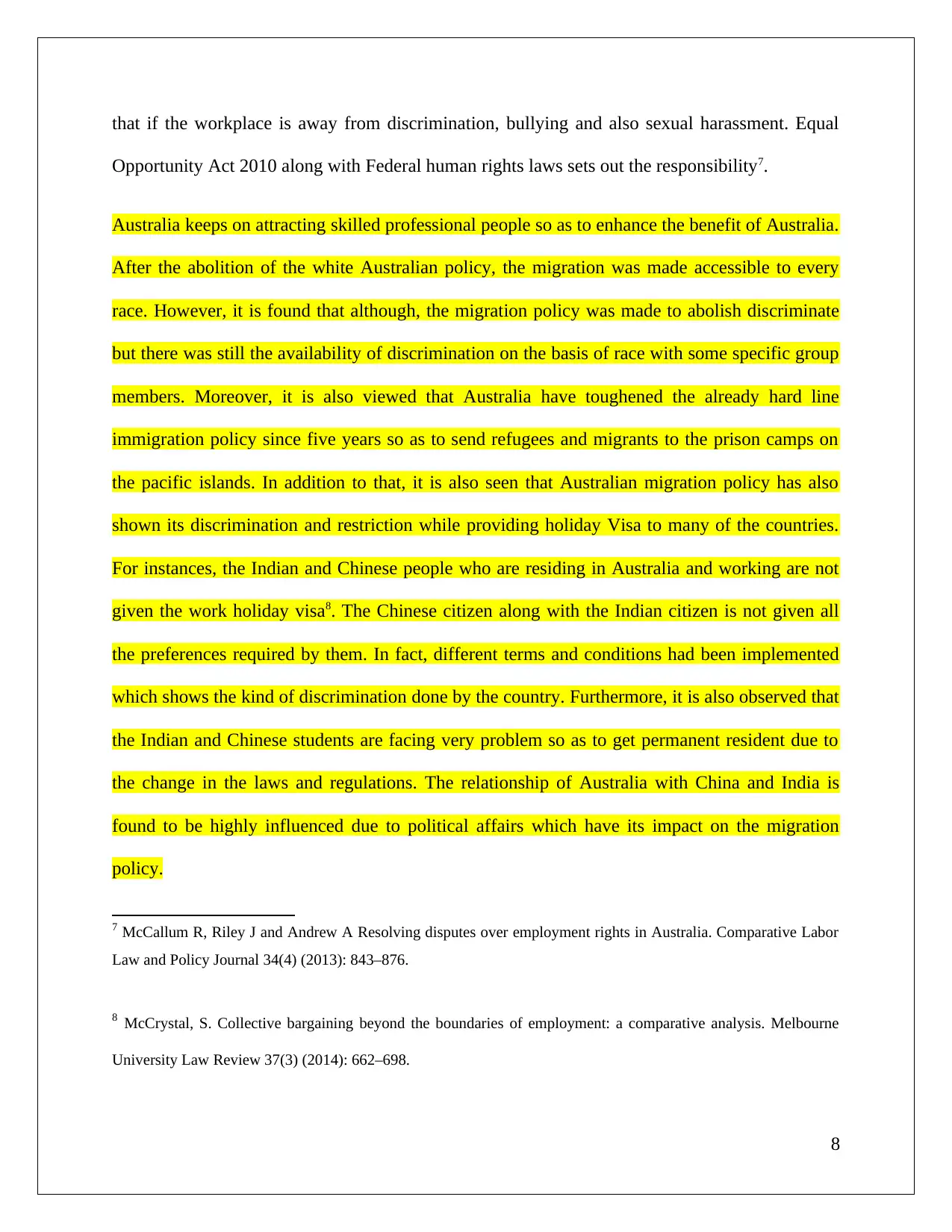
that if the workplace is away from discrimination, bullying and also sexual harassment. Equal
Opportunity Act 2010 along with Federal human rights laws sets out the responsibility7.
Australia keeps on attracting skilled professional people so as to enhance the benefit of Australia.
After the abolition of the white Australian policy, the migration was made accessible to every
race. However, it is found that although, the migration policy was made to abolish discriminate
but there was still the availability of discrimination on the basis of race with some specific group
members. Moreover, it is also viewed that Australia have toughened the already hard line
immigration policy since five years so as to send refugees and migrants to the prison camps on
the pacific islands. In addition to that, it is also seen that Australian migration policy has also
shown its discrimination and restriction while providing holiday Visa to many of the countries.
For instances, the Indian and Chinese people who are residing in Australia and working are not
given the work holiday visa8. The Chinese citizen along with the Indian citizen is not given all
the preferences required by them. In fact, different terms and conditions had been implemented
which shows the kind of discrimination done by the country. Furthermore, it is also observed that
the Indian and Chinese students are facing very problem so as to get permanent resident due to
the change in the laws and regulations. The relationship of Australia with China and India is
found to be highly influenced due to political affairs which have its impact on the migration
policy.
7 McCallum R, Riley J and Andrew A Resolving disputes over employment rights in Australia. Comparative Labor
Law and Policy Journal 34(4) (2013): 843–876.
8 McCrystal, S. Collective bargaining beyond the boundaries of employment: a comparative analysis. Melbourne
University Law Review 37(3) (2014): 662–698.
8
Opportunity Act 2010 along with Federal human rights laws sets out the responsibility7.
Australia keeps on attracting skilled professional people so as to enhance the benefit of Australia.
After the abolition of the white Australian policy, the migration was made accessible to every
race. However, it is found that although, the migration policy was made to abolish discriminate
but there was still the availability of discrimination on the basis of race with some specific group
members. Moreover, it is also viewed that Australia have toughened the already hard line
immigration policy since five years so as to send refugees and migrants to the prison camps on
the pacific islands. In addition to that, it is also seen that Australian migration policy has also
shown its discrimination and restriction while providing holiday Visa to many of the countries.
For instances, the Indian and Chinese people who are residing in Australia and working are not
given the work holiday visa8. The Chinese citizen along with the Indian citizen is not given all
the preferences required by them. In fact, different terms and conditions had been implemented
which shows the kind of discrimination done by the country. Furthermore, it is also observed that
the Indian and Chinese students are facing very problem so as to get permanent resident due to
the change in the laws and regulations. The relationship of Australia with China and India is
found to be highly influenced due to political affairs which have its impact on the migration
policy.
7 McCallum R, Riley J and Andrew A Resolving disputes over employment rights in Australia. Comparative Labor
Law and Policy Journal 34(4) (2013): 843–876.
8 McCrystal, S. Collective bargaining beyond the boundaries of employment: a comparative analysis. Melbourne
University Law Review 37(3) (2014): 662–698.
8
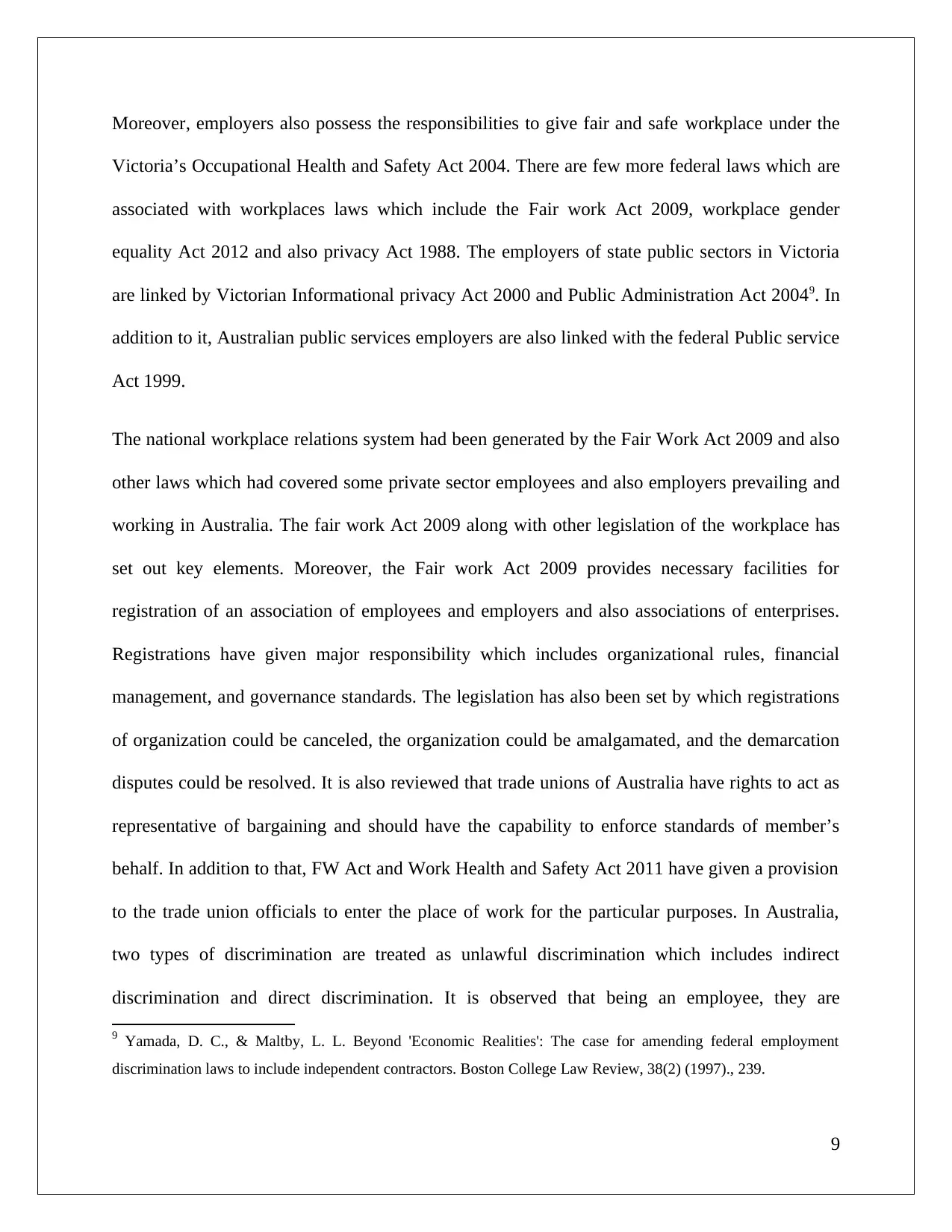
Moreover, employers also possess the responsibilities to give fair and safe workplace under the
Victoria’s Occupational Health and Safety Act 2004. There are few more federal laws which are
associated with workplaces laws which include the Fair work Act 2009, workplace gender
equality Act 2012 and also privacy Act 1988. The employers of state public sectors in Victoria
are linked by Victorian Informational privacy Act 2000 and Public Administration Act 20049. In
addition to it, Australian public services employers are also linked with the federal Public service
Act 1999.
The national workplace relations system had been generated by the Fair Work Act 2009 and also
other laws which had covered some private sector employees and also employers prevailing and
working in Australia. The fair work Act 2009 along with other legislation of the workplace has
set out key elements. Moreover, the Fair work Act 2009 provides necessary facilities for
registration of an association of employees and employers and also associations of enterprises.
Registrations have given major responsibility which includes organizational rules, financial
management, and governance standards. The legislation has also been set by which registrations
of organization could be canceled, the organization could be amalgamated, and the demarcation
disputes could be resolved. It is also reviewed that trade unions of Australia have rights to act as
representative of bargaining and should have the capability to enforce standards of member’s
behalf. In addition to that, FW Act and Work Health and Safety Act 2011 have given a provision
to the trade union officials to enter the place of work for the particular purposes. In Australia,
two types of discrimination are treated as unlawful discrimination which includes indirect
discrimination and direct discrimination. It is observed that being an employee, they are
9 Yamada, D. C., & Maltby, L. L. Beyond 'Economic Realities': The case for amending federal employment
discrimination laws to include independent contractors. Boston College Law Review, 38(2) (1997)., 239.
9
Victoria’s Occupational Health and Safety Act 2004. There are few more federal laws which are
associated with workplaces laws which include the Fair work Act 2009, workplace gender
equality Act 2012 and also privacy Act 1988. The employers of state public sectors in Victoria
are linked by Victorian Informational privacy Act 2000 and Public Administration Act 20049. In
addition to it, Australian public services employers are also linked with the federal Public service
Act 1999.
The national workplace relations system had been generated by the Fair Work Act 2009 and also
other laws which had covered some private sector employees and also employers prevailing and
working in Australia. The fair work Act 2009 along with other legislation of the workplace has
set out key elements. Moreover, the Fair work Act 2009 provides necessary facilities for
registration of an association of employees and employers and also associations of enterprises.
Registrations have given major responsibility which includes organizational rules, financial
management, and governance standards. The legislation has also been set by which registrations
of organization could be canceled, the organization could be amalgamated, and the demarcation
disputes could be resolved. It is also reviewed that trade unions of Australia have rights to act as
representative of bargaining and should have the capability to enforce standards of member’s
behalf. In addition to that, FW Act and Work Health and Safety Act 2011 have given a provision
to the trade union officials to enter the place of work for the particular purposes. In Australia,
two types of discrimination are treated as unlawful discrimination which includes indirect
discrimination and direct discrimination. It is observed that being an employee, they are
9 Yamada, D. C., & Maltby, L. L. Beyond 'Economic Realities': The case for amending federal employment
discrimination laws to include independent contractors. Boston College Law Review, 38(2) (1997)., 239.
9
⊘ This is a preview!⊘
Do you want full access?
Subscribe today to unlock all pages.

Trusted by 1+ million students worldwide
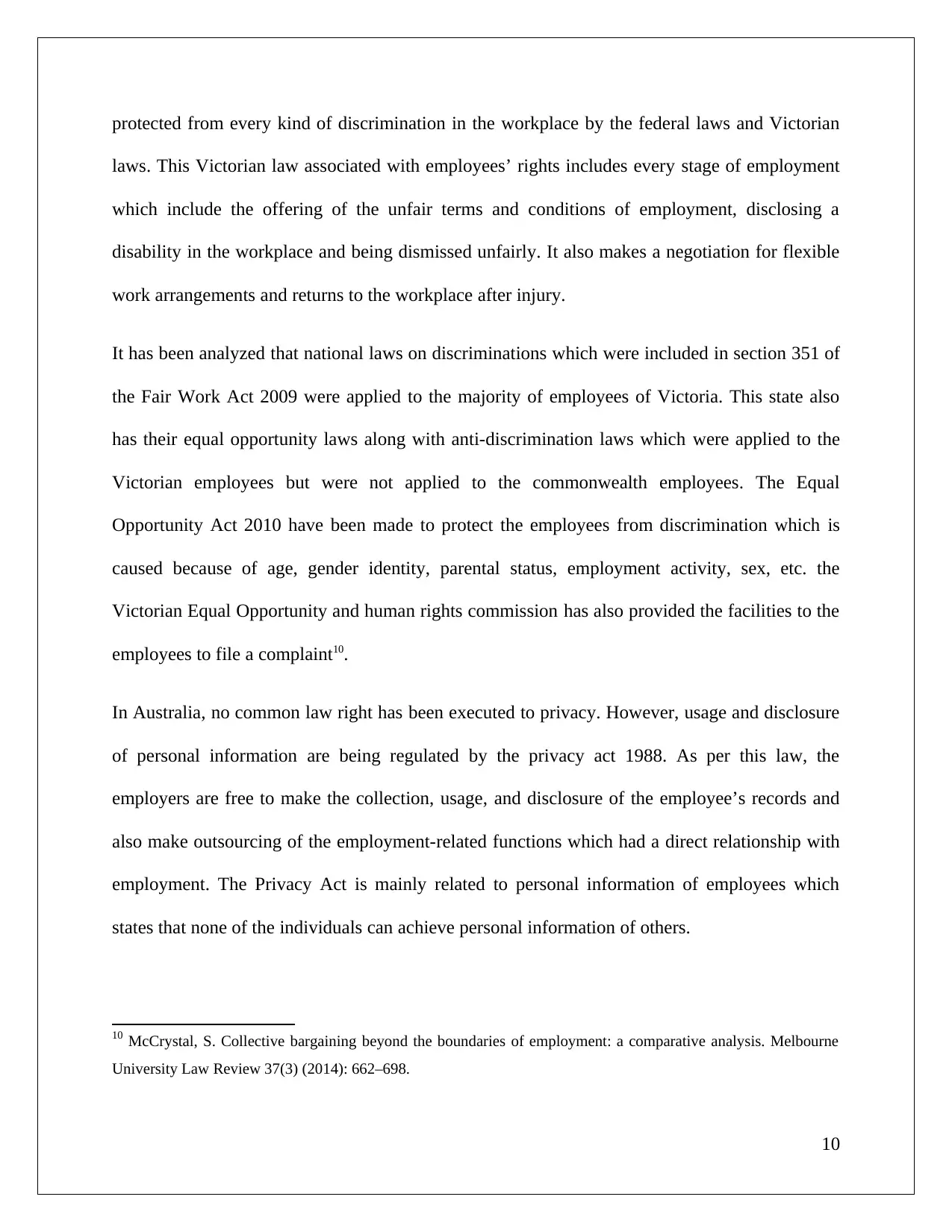
protected from every kind of discrimination in the workplace by the federal laws and Victorian
laws. This Victorian law associated with employees’ rights includes every stage of employment
which include the offering of the unfair terms and conditions of employment, disclosing a
disability in the workplace and being dismissed unfairly. It also makes a negotiation for flexible
work arrangements and returns to the workplace after injury.
It has been analyzed that national laws on discriminations which were included in section 351 of
the Fair Work Act 2009 were applied to the majority of employees of Victoria. This state also
has their equal opportunity laws along with anti-discrimination laws which were applied to the
Victorian employees but were not applied to the commonwealth employees. The Equal
Opportunity Act 2010 have been made to protect the employees from discrimination which is
caused because of age, gender identity, parental status, employment activity, sex, etc. the
Victorian Equal Opportunity and human rights commission has also provided the facilities to the
employees to file a complaint10.
In Australia, no common law right has been executed to privacy. However, usage and disclosure
of personal information are being regulated by the privacy act 1988. As per this law, the
employers are free to make the collection, usage, and disclosure of the employee’s records and
also make outsourcing of the employment-related functions which had a direct relationship with
employment. The Privacy Act is mainly related to personal information of employees which
states that none of the individuals can achieve personal information of others.
10 McCrystal, S. Collective bargaining beyond the boundaries of employment: a comparative analysis. Melbourne
University Law Review 37(3) (2014): 662–698.
10
laws. This Victorian law associated with employees’ rights includes every stage of employment
which include the offering of the unfair terms and conditions of employment, disclosing a
disability in the workplace and being dismissed unfairly. It also makes a negotiation for flexible
work arrangements and returns to the workplace after injury.
It has been analyzed that national laws on discriminations which were included in section 351 of
the Fair Work Act 2009 were applied to the majority of employees of Victoria. This state also
has their equal opportunity laws along with anti-discrimination laws which were applied to the
Victorian employees but were not applied to the commonwealth employees. The Equal
Opportunity Act 2010 have been made to protect the employees from discrimination which is
caused because of age, gender identity, parental status, employment activity, sex, etc. the
Victorian Equal Opportunity and human rights commission has also provided the facilities to the
employees to file a complaint10.
In Australia, no common law right has been executed to privacy. However, usage and disclosure
of personal information are being regulated by the privacy act 1988. As per this law, the
employers are free to make the collection, usage, and disclosure of the employee’s records and
also make outsourcing of the employment-related functions which had a direct relationship with
employment. The Privacy Act is mainly related to personal information of employees which
states that none of the individuals can achieve personal information of others.
10 McCrystal, S. Collective bargaining beyond the boundaries of employment: a comparative analysis. Melbourne
University Law Review 37(3) (2014): 662–698.
10
Paraphrase This Document
Need a fresh take? Get an instant paraphrase of this document with our AI Paraphraser
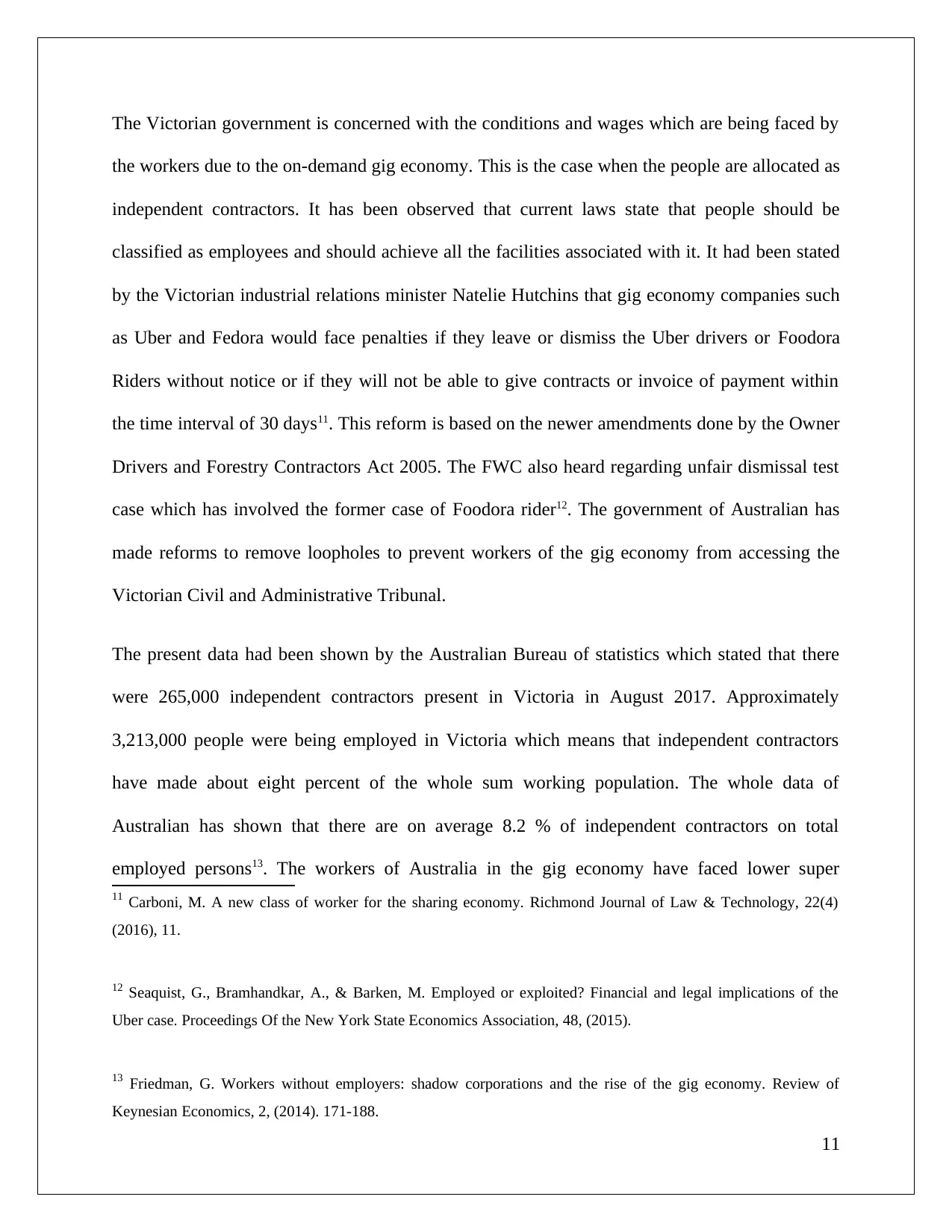
The Victorian government is concerned with the conditions and wages which are being faced by
the workers due to the on-demand gig economy. This is the case when the people are allocated as
independent contractors. It has been observed that current laws state that people should be
classified as employees and should achieve all the facilities associated with it. It had been stated
by the Victorian industrial relations minister Natelie Hutchins that gig economy companies such
as Uber and Fedora would face penalties if they leave or dismiss the Uber drivers or Foodora
Riders without notice or if they will not be able to give contracts or invoice of payment within
the time interval of 30 days11. This reform is based on the newer amendments done by the Owner
Drivers and Forestry Contractors Act 2005. The FWC also heard regarding unfair dismissal test
case which has involved the former case of Foodora rider12. The government of Australian has
made reforms to remove loopholes to prevent workers of the gig economy from accessing the
Victorian Civil and Administrative Tribunal.
The present data had been shown by the Australian Bureau of statistics which stated that there
were 265,000 independent contractors present in Victoria in August 2017. Approximately
3,213,000 people were being employed in Victoria which means that independent contractors
have made about eight percent of the whole sum working population. The whole data of
Australian has shown that there are on average 8.2 % of independent contractors on total
employed persons13. The workers of Australia in the gig economy have faced lower super
11 Carboni, M. A new class of worker for the sharing economy. Richmond Journal of Law & Technology, 22(4)
(2016), 11.
12 Seaquist, G., Bramhandkar, A., & Barken, M. Employed or exploited? Financial and legal implications of the
Uber case. Proceedings Of the New York State Economics Association, 48, (2015).
13 Friedman, G. Workers without employers: shadow corporations and the rise of the gig economy. Review of
Keynesian Economics, 2, (2014). 171-188.
11
the workers due to the on-demand gig economy. This is the case when the people are allocated as
independent contractors. It has been observed that current laws state that people should be
classified as employees and should achieve all the facilities associated with it. It had been stated
by the Victorian industrial relations minister Natelie Hutchins that gig economy companies such
as Uber and Fedora would face penalties if they leave or dismiss the Uber drivers or Foodora
Riders without notice or if they will not be able to give contracts or invoice of payment within
the time interval of 30 days11. This reform is based on the newer amendments done by the Owner
Drivers and Forestry Contractors Act 2005. The FWC also heard regarding unfair dismissal test
case which has involved the former case of Foodora rider12. The government of Australian has
made reforms to remove loopholes to prevent workers of the gig economy from accessing the
Victorian Civil and Administrative Tribunal.
The present data had been shown by the Australian Bureau of statistics which stated that there
were 265,000 independent contractors present in Victoria in August 2017. Approximately
3,213,000 people were being employed in Victoria which means that independent contractors
have made about eight percent of the whole sum working population. The whole data of
Australian has shown that there are on average 8.2 % of independent contractors on total
employed persons13. The workers of Australia in the gig economy have faced lower super
11 Carboni, M. A new class of worker for the sharing economy. Richmond Journal of Law & Technology, 22(4)
(2016), 11.
12 Seaquist, G., Bramhandkar, A., & Barken, M. Employed or exploited? Financial and legal implications of the
Uber case. Proceedings Of the New York State Economics Association, 48, (2015).
13 Friedman, G. Workers without employers: shadow corporations and the rise of the gig economy. Review of
Keynesian Economics, 2, (2014). 171-188.
11
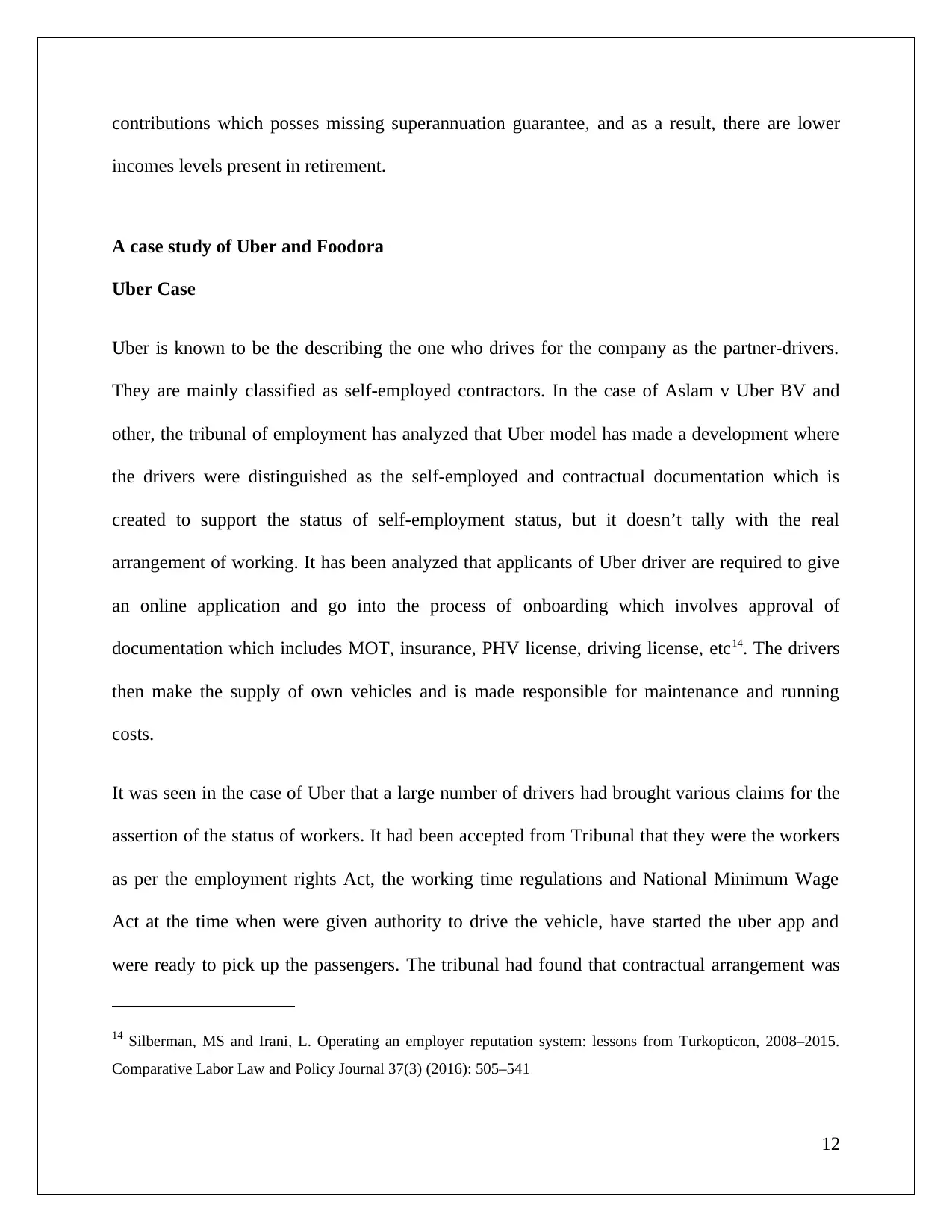
contributions which posses missing superannuation guarantee, and as a result, there are lower
incomes levels present in retirement.
A case study of Uber and Foodora
Uber Case
Uber is known to be the describing the one who drives for the company as the partner-drivers.
They are mainly classified as self-employed contractors. In the case of Aslam v Uber BV and
other, the tribunal of employment has analyzed that Uber model has made a development where
the drivers were distinguished as the self-employed and contractual documentation which is
created to support the status of self-employment status, but it doesn’t tally with the real
arrangement of working. It has been analyzed that applicants of Uber driver are required to give
an online application and go into the process of onboarding which involves approval of
documentation which includes MOT, insurance, PHV license, driving license, etc14. The drivers
then make the supply of own vehicles and is made responsible for maintenance and running
costs.
It was seen in the case of Uber that a large number of drivers had brought various claims for the
assertion of the status of workers. It had been accepted from Tribunal that they were the workers
as per the employment rights Act, the working time regulations and National Minimum Wage
Act at the time when were given authority to drive the vehicle, have started the uber app and
were ready to pick up the passengers. The tribunal had found that contractual arrangement was
14 Silberman, MS and Irani, L. Operating an employer reputation system: lessons from Turkopticon, 2008–2015.
Comparative Labor Law and Policy Journal 37(3) (2016): 505–541
12
incomes levels present in retirement.
A case study of Uber and Foodora
Uber Case
Uber is known to be the describing the one who drives for the company as the partner-drivers.
They are mainly classified as self-employed contractors. In the case of Aslam v Uber BV and
other, the tribunal of employment has analyzed that Uber model has made a development where
the drivers were distinguished as the self-employed and contractual documentation which is
created to support the status of self-employment status, but it doesn’t tally with the real
arrangement of working. It has been analyzed that applicants of Uber driver are required to give
an online application and go into the process of onboarding which involves approval of
documentation which includes MOT, insurance, PHV license, driving license, etc14. The drivers
then make the supply of own vehicles and is made responsible for maintenance and running
costs.
It was seen in the case of Uber that a large number of drivers had brought various claims for the
assertion of the status of workers. It had been accepted from Tribunal that they were the workers
as per the employment rights Act, the working time regulations and National Minimum Wage
Act at the time when were given authority to drive the vehicle, have started the uber app and
were ready to pick up the passengers. The tribunal had found that contractual arrangement was
14 Silberman, MS and Irani, L. Operating an employer reputation system: lessons from Turkopticon, 2008–2015.
Comparative Labor Law and Policy Journal 37(3) (2016): 505–541
12
⊘ This is a preview!⊘
Do you want full access?
Subscribe today to unlock all pages.

Trusted by 1+ million students worldwide
1 out of 25
Related Documents
Your All-in-One AI-Powered Toolkit for Academic Success.
+13062052269
info@desklib.com
Available 24*7 on WhatsApp / Email
![[object Object]](/_next/static/media/star-bottom.7253800d.svg)
Unlock your academic potential
Copyright © 2020–2025 A2Z Services. All Rights Reserved. Developed and managed by ZUCOL.





